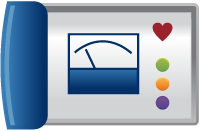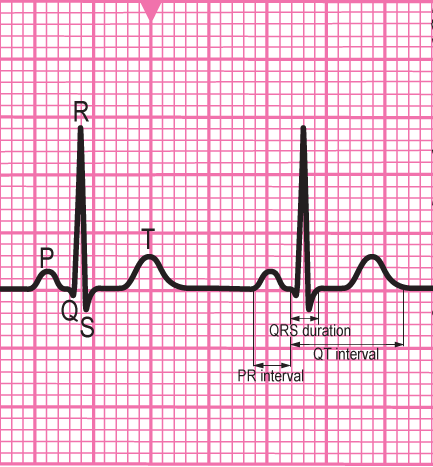
Interpreting the ECG
You observe a change in rhythm.
Answer the first question then select Confirm. Once you have read the feedback, answer the remaining questions as they become active. Roll over the rhythm strip to see a larger image.
Answer the first question then select Confirm. Once you have read the feedback, answer the remaining questions as they become active. Roll over the rhythm strip to see a larger image.


1. Is there any electrical activity?
2. Is the ventricular (QRS) rate normal?
3. Is the QRS rhythm regular?
4. Is the QRS complex width normal?
5. Is atrial activity present?
6. Is atrial activity related to ventricular activity and, if so how?
References
See chapter 8 of the ALS manual for further reading about how to analyse cardiac rhythm from the ECG.
Components of a normal ECG rhythm strip
- Depolarisation begins in the SA node and then spreads through the atrial myocardium
- This depolarisation is recorded on the rhythm strip as the P wave. The heart responds to this electrical stimulus byatrial contraction
- The small isoelectric segment between the P wave and QRS complex represents the delay in transmission through the AV node
- Depolarisation of the bundle of His, bundle branches and ventricular myocardium is shown on the rhythm strip as the QRS complex
- The T wave represents recovery of the resting potential (repolarisation) in the cells of the conducting system and ventricular myocardium



The 6-stage approach
1. Is there any electrical activity?
2. What is the ventricular (QRS) rate?
3. Is the QRS rhythm regular or irregular?
4. Is the QRS width normal (narrow) or broad?
Any cardiac rhythm can be described accurately and managed safely and effectively using the first four stages.
5. Is atrial activity present? (If so, what is it? Typical sinus P waves? Atrial fibrillation? Atrial flutter? Abnormal P waves?)
6. How is atrial activity related to ventricular activity? (E.g 1:1 conduction, 2:1 conduction, etc, or no relationship.)

Settings
Font colour
default inverted high contrast high contrast inverted high contrast soft green on blackSample text
text looks like thisTEXT LOOKS LIKE THIS


 Yes
Yes



